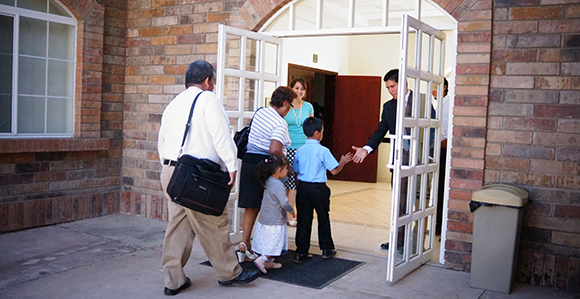
Have you ever wondered about the adaptations of our Sabbath Day? When I was young, we went to church morning and afternoon on Sundays and had auxiliary meetings during the week. It’s interesting to see how our Sabbath worship has changed over the years.
The Church was organized in 1830, but the first Sabbath Day worship instruction wasn’t given until 1831 in Missouri. Until that time, Sunday meetings adopted the Protestant format of meeting twice, morning and afternoon, in large gatherings with singing, preaching, and praying.
Partaking of the Sacrament must have been interesting. Back in those days, there were only a few cups for water, and a few platters for bread spread throughout the congregation. It must have been horrible during the flu season! It wasn’t until 1911 that individual cups —glass, metal, paper, and finally plastic—were made available.
There weren’t very many buildings big enough to house all the members, so often meetings were held in a schoolhouse, grove, or bowery; if they were lucky. Would you still attend church in a driving rainstorm, gale, or blizzard?
The hope was that Jackson County, Missouri was a place to create roots for the church. Instructions from the Lord began to shape their religion. Section 59 of the Doctrine and Covenants offers more specifics of the importance of the Sabbath Day.
“And that thou mayest more fully keep thyself unspotted from the world, thou shalt go to the house of prayer and offer up thy sacraments upon my holy day;
“For verily this is a day appointed unto you to rest from your labors, and to pay thy devotions unto the Most High;”
“And on this day thou shalt do none other thing, only let thy food be prepared with singleness of heart that thy fasting may be perfect, or, in other words, that thy joy may be full” (D&C 59:9-10, 13).
President George A. Smith, speaking at a conference in the Salt Lake Tabernacle, used for the basis of his sermon the rules of the United Order, which are very similar to the 10 Commandments. When speaking of the Sabbath Day, he says,
“We will observe the Sabbath day and keep it holy. I regret to say that I have noticed a great many instances of laxity in the observance of this rule, and I wish the Elders and teachers in all the Branches and settlements to preach and practice the observance of the Sabbath. Brethren, work six days, and on the seventh rest and observe the Sabbath according to the revelation; and impress this principle upon the Saints everywhere by practice. … I do not believe that, as a general thing, anything is gained in property or in time by working on the Sabbath; and I advise and exhort all men professing to belong to the United Order, or to be Latter-day Saints, to observe the Sabbath; keep it holy, devote it to worship, to the study of good books, to rest, to imparting instruction, to attending meeting, and do not, under any circumstances, lapse into a habit of thinking that you can do as you please on the Sabbath” (JD, 17:254).
In Nauvoo, they attempted to divide up into multiple wards, but that wasn’t really established until they settled into the Salt Lake Valley. It’s very interesting how they set up the wards. You can read about it here.
Richard Ballantyne was the first to offer a Sunday School for children in 1849. In the 1870s, the responsibility for setting up and passing the Sacrament was given to the young men. Previously, the bishoprics did everything.
The Young Women’s organization began in 1869 and has gone through many changes over the years.
Primary came about in 1878 when Aurelia S. Rogers decided it was high time to corral the boys.
Fast Day was originally held on the first Thursday of every month. But because so many people worked or attended school, in 1897, they moved it to the first Sunday.
Pres. Spencer W. Kimball announced, in 1980, the three-hour block of meetings. Relief Society, Primary, Young Men and Young Women meetings were all moved to Sundays. The reason for this drastic change (at the sacrifice of many auxiliary workers) was to allow time, on Sundays, to worship the Lord as a family at home.
Each time the church attempts to streamline our meetings, it is always for the purpose of allowing more time to gather—in worship—as a family.
Recently, we experienced another change, but with the same purpose in mind. It’s all well and good to go to church to feel the spirit of the Lord. But, feeling the spirit of the Lord on the Sabbath Day has always been the responsibility of a father and mother in the home.